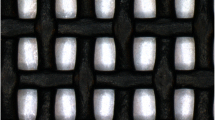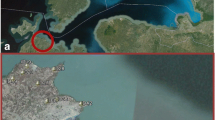Abstract
The outbreak of bluetongue (BTV-8) in many parts of north-western Europe led to efforts to curb the spread of the disease, particularly in farms with valuable livestock, as on a stud bull farm in Schmergow, Brandenburg, Germany. In the abundance of the putative BT vectors, Palaearctic Culicoides species, several vector control methods were applied in the hope for a reduction of the target insect populations. Insecticide-impregnated ear tags and regular treatments at 6-week intervals of all bulls with deltamethrin pour on were expected to achieve the desired control of the biting midges. Additionally, insecticide-treated mosquito fences circumventing much of the pens were tried for the first time against Culicoides. Two suction black-light traps (BioGents® sentinel traps) helped to monitor the densities of Culicoides and other haematophagous nematocera during the trial period from July to December 2007. Despite all efforts, the densities of Culicoides were not distinctly reduced. Several thousand midges were repeatedly recorded during one-night catches. Examinations of midges and other haematophagous nematocera (Aedes and Anopheles species) revealed high percentages of successful feedings between 10% and 35% for Culicoides and more than 50% for Aedes and Anopheles species. Since all insects were caught inside the pens, the concept of endophily vs exophily or endophagy vs exophagy for some Culicoides species needs to be revised accordingly. Also, stabling of valuable livestock does not reduce the host–vector interface and, hence, the risk of transmission of BT.






Similar content being viewed by others
References
Bauer B, Amsler S, Kabore I, Petrich-Bauer J (1995) Application of synthetic pyrethroids to cattle. Laboratory trials and tsetse control operations with specific consideration of extension to rural communities OAU/STRC, Nairobi. Proceedings of the 22nd Meeting of the International Scientific Council for Trypanosomiasis Research and Control, Kampala, Uganda, 1993, pp 276–279
Bauer B, Gitau D, Oloo FP, Karanja SM (2006) Evaluation of a preliminary trial to protect zero-grazed dairy cattle with insecticide-treated mosquito netting in Western Kenya. Trop Anim Health Prod 38:29–34
Bouyer F, Stachurski F, Kaboré I, Bauer B, Lancelot R (2007) Tsetse control in cattle from pyrethroid footbaths. Prev Vet Med 78:223–238
Carpenter S, McArthur C, Selby R, Ward R, Nolan DV, Mordue Luntz AJ, Dallas JF, Tripet F, Mellor PS (2008) Experimental infection studies of UK Culicoides species midges with bluetongue virus serotypes 8 and 9. Vet Rec 163:589–592
Clausen P-H, Stephan A, Bartsch S, Jandowsky A, Hoffmann-Köhler P, Schein E, Mehlitz D, Bauer B (2009) Seasonal dynamics of biting midges (Diptera: Ceratopogonidae, Culicoides spp.) on dairy farms of central Germany during the 2007/08 epidemic of bluetongue. Parasitol Res. in press
Dijkstra E, Van Der Ven IJK, Meiswinkel R, Holzel DR, Van Rijn PA, Meiswinkel R (2008) Culicoides chiopterus as a potential vector of bluetongue virus in Europe. Vet Rec 162:422
European Food Safety Authority (EFSA) (2008) Opinion of the Scientific Panel on Animal Health and Welfare on request from the Commission on Bluetongue. 70 pp. Available at http://www.efsa.europa.eu/EFSA/efsa_locale-1178620753812_12119020087
Liebisch A, Liebisch G, Heine S, Thienel S, Hinrichs P (2008) Wirksamkeit von Auriplak Ohrclips (Permethrin) gegen Gnitzen (Culicoides) als Überträger des Bluetongue Virus bei Rindern. Prakt Tierarzt 89:128–141
Maia M, Bauer B, Mehlitz D, Clausen P-H, Abonuusum A, Osei S, Kruppa T, May J, Garms R (2005) Use of insecticide-treated nets to protect cattle against insects of veterinary and medical importance in Ghana. BNI Report 04/05, pp 86–87
Mehlhorn H, Walldorf V, Klimpel S, Jahn B, Jaeger F, Eschweiler J, Hoffmann B, Beer M (2007) First occurrence of Culicoides obsoletus-transmitted bluetongue virus epidemic in Central Europe. Parasitol Res 101:219–228
Mehlhorn H, Schmahl G, D’Haese J, Schumacher B (2008) Butox 7.5 pour on: a deltamethrin treatment of sheep and cattle: pilot study of killing on Culicoides species (Ceratopogonidae). Parasitol Res 102:515–518
Meiswinkel R, Van Rijn P, Leijs P, Goffredo M (2007) Potential new Culicoides vector of bluetongue virus in northern Europe. Vet Rec 161:564–565
Meiswinkel R, Baldet T, de Deken R, Takken W, Delécolle J-C, Mellor PS (2008) The 2006 outbreak of bluetongue in northern Europe—the entomological perspective. Prev Vet Med 87:55–63
Schmahl G, Walldorf V, Klinpel S, Al-Quraishy S, Mehlhorn H (2008) Efficacy of Oxyfly™ on Culicoides species—the vectors of bluetongue virus—and other insects. Parasitol Res 102:1101–1103
Stachurski F, Lancelot R (2006) Foot-bath acaricide treatment to control cattle infestation by the tick Amblyomma variegatum. Med Vet Entomol 20:402–412
Vogel G (1959) Zur Bestimmung von glomulärer Filtrationsrate und filtrierender Fläche in der Niere einiger Haussäugetiere. Pflügers Arch 269:264–269
Acknowledgements
The insecticide-treated mosquito nets for the protection of the farm were provided by Vestergaard Frandsen SA, Lausanne, Switzerland. Culicoides nubeculosus were provided free of charge from IAH, Pirbright, UK, courtesy of Messieurs Philipp Mellor, Simon Carpenter and Eric Denison. We are indebted to the farm management in Schmergow, particularly Mr Robert Dittmann, for their active support.
Author information
Authors and Affiliations
Corresponding author
Rights and permissions
About this article
Cite this article
Bauer, B., Jandowsky, A., Schein, E. et al. An appraisal of current and new techniques intended to protect bulls against Culicoides and other haematophagous nematocera: the case of Schmergow, Brandenburg, Germany. Parasitol Res 105, 359–365 (2009). https://doi.org/10.1007/s00436-009-1410-4
Received:
Accepted:
Published:
Issue Date:
DOI: https://doi.org/10.1007/s00436-009-1410-4




